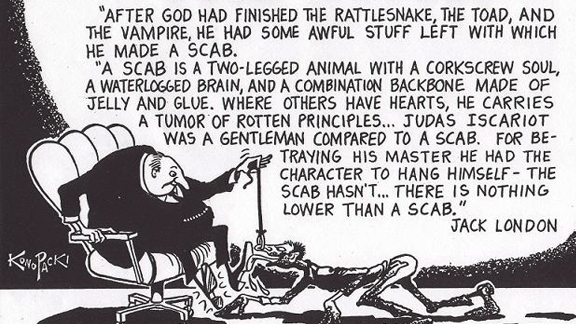I call it scab

The CFMEU is fighting for the right to call a scab a scab. “The word ‘scab’ is of common and historical use in Australian industrial disputes”, says CFMEU national vice president Andrew Vickers. Bosses want its use made a sackable offence.
The union has taken the issue all the way to the High Court. The case stems from 2012 strike action against BHP Mitsubishi Alliance involving 3,000 miners working in Queensland’s Bowen Basin. One striking worker was sacked for carrying a sign displaying factual information: “No Principles – Scabs – No Guts”. BHP says it should be able to control the “degree of decorum” on picket lines.
This case is about the right to call a spade a spade. Vickers is right: Australian folk history is littered with references to scabs and their generally scabby behaviour. And there’s a deadly serious point to this vilification.
Australian cultural icon Banjo Paterson was contemptuous of scabs. His poem known as “Travelling Down the Castlereagh” reads: “I asked a cove for shearing once along the Marthaguy/ ‛We shear non-union here’ says he. ‛I call it scab,’ says I.”
In Broken Hill hangs a painting by Howard William Steer and Clark Barrett titled “United We Stand”. It depicts miners holding the police at bay while women tar and feather scabs.
Wharfies are another group famed for their hatred of scabs. This isn’t a natural aversion; it’s a political lesson. During the bitter waterfront strike of 1928, strikebreakers who responded to the calls of the shipowners and the Hogan Labor government for “volunteers” quite literally took the food from the mouths of wharfies’ children. The experience of hardship and naked class warfare fostered hostility to the scabs. A poem from the time read: “The Lord above, send down a dove/ With wings as sharp as razors/ To slit the throats of the bloody scabs/ Who cut down poor men’s wages.”
The scabs actually formed their own union called the Permanent and Casuals’ Wharf Labourers’ Union – known as “the P and C”. Its aim was to “preserve peace in the industry … by forbidding hold-ups, stoppages and strikes by its members”.
Despite enjoying special government protection, no scab was safe in Port Melbourne. Jim Nager, a union man at the time, recalled, “Many residents of the Port thought no more of killing a scab than an enemy soldier in war.”
The state certainly carries out strikebreaking as something akin to an act of war.
In 1949 the Chifley Labor government sent thousands of troops to work the coal mines in NSW to break a strike led by the Miners’ Federation. It wasn’t the first time – or the last – that military forces have been used in Australia as strikebreakers.
Governments and bosses have often orchestrated mass politically motivated scabbing. “The Slimy Patrick’s Scab” is a song that describes the “vampire bats and sewer rats” who did the company’s bidding during the 1998 waterfront dispute. In an attempt to break the MUA, the Howard government and Patricks colluded to train ex-SAS officers as scabs in Dubai. The richest lobby group in the country, the ultra-right wing National Farmers’ Federation, formed a labour hire company as part of the conspiracy. They named their company P&C Stevedores after the old scab union: history matters.
In the labour movement, that special loathing reserved for scabs is a necessary – and often painfully learnt – political lesson born of class struggle.